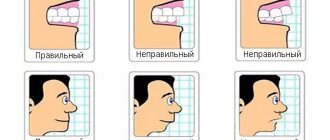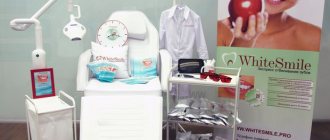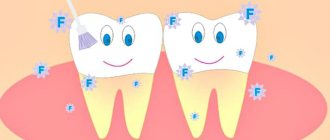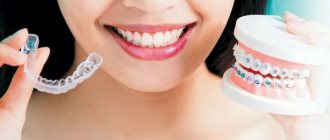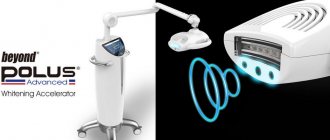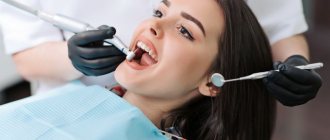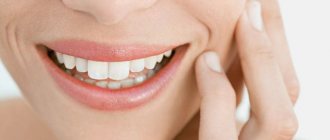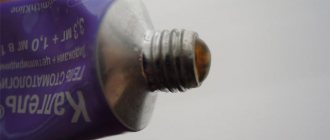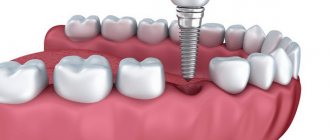What are mouth guards for straightening teeth in children?
Orthodontic aligners are used to correct bite not only in children, but also in adults. These are removable plates that need to be constantly worn on the teeth, removed only during meals and hygiene procedures. The plates are made individually for each patient. Most often, silicone mouth guards, as well as thermoplastic or polyurethane plates, are used to straighten teeth in children. There are two main types of mouth guards used for children: trainers and aligners. They differ in appearance and functions.
Trainers for children
Trainers are mainly used at an early age - from 3 to 9 years, during the period of baby teeth and mixed dentition. They correct defects in the development of the dental system associated with various dysfunctions.
Often problems with bite are complex, for example associated with improper breathing. In particular, a small child may have enlarged adenoids, he cannot breathe fully through his nose and uses his mouth to do this. If this continues for a long time, then a number of problems arise.
- The upper jaw is formed incorrectly - it narrows in the lateral sections, as a result there is not enough space for the eruption of permanent teeth.
- Improper development of the upper jaw causes developmental defects in the lower jaw, and diction suffers from this.
- The muscles of the lips, tongue, and cheeks also do not work correctly, which negatively affects the aesthetics of the face: the neck is pulled forward, the lower third of the face lengthens, and the middle zone is poorly developed.
- The child cannot swallow fully, which affects digestion.
In this case, the orthodontist may recommend wearing trainers - they help the eruption of permanent teeth, develop the muscles of the oral cavity, help restore proper breathing, and shape posture. These mouthguards are worn during the day for several hours and throughout the night. The treatment process can be supplemented with developmental exercises.
The role of a mouthguard after braces
The installed structures can successfully cope with malocclusion and evenness of the dentition, but after their removal the treatment does not end yet. Wearing the system can only be called the first stage of this process, since teeth that have been moved into the desired position can return to their original state. This is due to the natural reaction of the human body to the mechanical impact exerted on it.
It is to prevent the gradual return of crooked teeth that dental mouth guards are needed. These devices help keep the jaw rows in the desired position without any discomfort; in addition, their use is justified from the point of view of additional protection for the teeth. An example is sports mouth guards, which are widely used, for example, in hockey or boxing.
Aligners for children
Aligners are most often used to straighten already permanent teeth at an early age. They are absolutely transparent, miniature in size and accurately follow the shape of the teeth.
You can only notice a mouthguard in a person’s mouth from a very close distance. It has minimal effect on articulation (pronunciation of sounds).
Be like a star!
Persuading a child to wear a mouth guard all the time is quite difficult, but it is possible. Children often imitate performers and actors. A worthy argument in favor of aligners is that they were once worn by such stars as Justin Bieber, Khloe Kardashian, Zac Efron, Tom Cruise. They calmly appeared in public, performed, and communicated with people.
How children are treated with aligners to straighten teeth
Mouthguards are manufactured as a set for the entire duration of treatment. They are numbered so as not to be confused. The plates must be changed on a schedule every 2-4 weeks.
The material from which the mouth guards are made is elastic, does not injure soft tissues, and does not scratch tooth enamel. And at the same time, it has a certain rigidity to specifically move teeth into the correct position. The process occurs delicately and softly due to the fact that the entire amplitude of tooth movement is distributed over several drops. But it should be borne in mind that the price of mouth guards for straightening teeth in children is higher than for braces.
Aesthetic onlays for teeth
By “Hollywood” we mean a snow-white, even smile, which is associated with the smiles of movie stars - the generally accepted standard is four front teeth that are level with each other. In this case, the teeth must be large enough. In Russia, this concept simply means straight and white teeth. A similar result can be achieved in various ways. If, due to aesthetic defects, increased sensitivity or slight curvature of teeth, it is not possible to limit yourself to minimally invasive procedures, then cosmetic dental veneers are used. In aesthetic dentistry the following are used: veneers, ultraneers, compositers and lumineers. All of these types of aesthetic dental onlays are made in a dental laboratory using individual impressions of the patient’s teeth and then attached to the enamel surface.
In order to improve the aesthetics of the dentition, including hiding minor defects in the surface of the teeth, ceramic dental veneers are most often used, since this material is closest to the natural tooth enamel. The peculiarity of installing such onlays on teeth is that the procedure requires preliminary grinding of the enamel to the thickness of the veneer (0.3 - 0.7 mm). In addition, vinyl overlays for teeth are often used today; they are somewhat inferior to ceramic veneers in terms of characteristics, but are more affordable in cost. The number of plates installed may vary depending on the width of the smile. In cases where the teeth are severely damaged (less than 10% of the tissue remains) or there is a slight curvature of the dentition, crowns are used to achieve a Hollywood smile.
To achieve maximum strength, veneers are made of zirconium dioxide or aluminum (only the frame is made of metal, and the upper crown is made of ceramic), but in this case, the onlays on the teeth do not transmit light as well, so upon close examination the difference may be noticeable. In this regard, it is worth making an informed decision: either ceramic veneers for 5–8 years, or zirconium veneers for 15–20 years.
Benefits of mouth guards
- With their help, many bite defects can be corrected, with the exception of those associated with improper development of the skull bones.
- According to reviews, mouthguards for straightening teeth in children do not cause discomfort, they are easy to get used to, and do not injure the mucous membranes.
- The aesthetics of the dentition is preserved, which means the child’s mental state does not suffer.
- If it is quite difficult to care for braces, then the aligners can be easily removed to clean your teeth and put back on.
- You need to visit the doctor less often than when treating with braces - once every 1.5-2 months.
Care and possible problems
If the doctor does not follow the microprosthetics technique, veneers can quickly come off, change shade, do not fit in shape/size, and darkening occurs at the segments of the joints of the plate and the tooth. It is recommended to choose a good clinic for treatment, which has modern equipment and highly qualified specialists, since the duration of operation and the result of the work directly depend on the professionalism of the dentist.
After the procedure, sometimes minor irritation occurs; redness of the gum mucosa is normal. Subsequent care involves the use of pastes with a low content of abrasive components, a soft brush, and an irrigator.
The durability of the onlays depends on three factors - the material of the prosthesis, the quality of installation, and proper hygiene. The main rule is that the patient must remember that he has artificial structures installed that need special attention:
- You should brush your teeth twice a day, using a soft brush, a paste with a minimal abrasive content, and floss to remove plaque in hard-to-reach areas;
- It is forbidden to chew seeds, nuts, and candies;
- it is necessary to avoid intense stress when chewing food, biting, blows to the jaw segment with fixed pads, reduce the consumption of coloring products - beets, red wine, strong tea;
- It is recommended to visit the dentist twice a year for professional teeth cleaning.
If roughness/gaps occur at the attachment site, a chipped part of the restoration, signs of carious lesions, mobility of the prosthesis, or pain, you must consult a doctor who will polish or correct the onlay.
Flaws
Many parents believe that if they buy mouthguards to straighten their children’s teeth, they can solve any bite problems, including the most complex ones. Unfortunately, even top aligner manufacturers admit that significant defects, as well as open, distal, and mesial bites can only be corrected with the help of braces. Therefore, correction with mouthguards is possible only for minor malocclusions.
Another drawback concerns the discipline of wearing mouth guards. Individual children may remove the covers at school and only put them on in front of their parents. In this case, reasoned explanatory work is required, otherwise the effectiveness of treatment will be reduced to zero.
The price of aligners for children is higher than braces. This is especially true for products of famous brands. The average cost of a kit for the entire treatment period can reach up to 150,000 rubles.
Getting ready to put on mouth guards
The process of preparing and putting on a mouthguard is not particularly difficult and involves the following actions:
- Taking impressions of the jaws on an individual basis.
- Manufacturing of overlays.
- Adjusting the trays to the dentition until the patient no longer experiences even the slightest sensation of discomfort.
When wearing such devices, it is important to carefully follow the doctor’s recommendations and adhere to simple rules of hygiene and oral care. There is nothing complicated about this, and following them will allow you to achieve the desired result.
Manufacturing
During the preparation, the doctor cleans the little patient’s teeth with ultrasound and, if necessary, treats caries to eliminate sources of infection in the mouth. After this, an impression of the dentition is taken and an X-ray is taken.
In the manufacturer’s laboratory, using computer software, they create a virtual model of the aligners, program the movement of the teeth and the final result. Then a set of individual plates is made using this model. The whole process takes 1-2 weeks. During the fitting, the doctor tells the child and parents how to use and care for the mouth guards.
Care of mouth guards
No particularly complicated care is required for the aligners. However, it is necessary to monitor the condition of the structures and maintain oral hygiene from the first days of wearing this device.
The main thing is to follow a number of rules that should become a habit. Here are the main ones:
- To avoid deformation, mouthguards should not be exposed to high temperatures. It is strictly forbidden to use boiling, steaming, using hot water or drying over hot surfaces to disinfect aligners. It is also not recommended to drink too hot drinks or food while wearing a mouthguard.
To keep the polymer pad clean, it should be cleaned with a regular toothbrush and rinsed with water.
- For cleaning, use the same toothpaste as for brushing your teeth. It is best to clean your aligners in the morning, evening and afternoon, if possible. If the aligners are not cleaned for a long time, an unpleasant taste appears in the mouth, and food debris accumulates under the plastic structures.
- Even if the patient did not wear the mouth guards during the day, it is better to wash and clean them in the evening (to prevent the growth of serious pathogenic bacteria). After all, it is prohibited to use any type of heat treatment for plastic mouthguards.
- Sometimes experts recommend special solutions that disinfect the pad and prevent it from becoming covered with plaque.
- It is very convenient to use special cases for caring for mouthguards and carrying them. The range of such boxes is quite wide; they are compact and have special holes. But thrifty patients use cleanly washed jars of some cream to store their trays. After all, the main thing here is not design, but cleanliness and convenience. In this type of design you can always carry it with you.
